Attached files
| file | filename |
|---|---|
| 8-K - 8-K ON 4Q EARNINGS RELEASE - WESBANCO INC | wsbc-8k_20210126.htm |
| EX-99.1 - EX-99.1 EARNINGS RELEASE - WESBANCO INC | wsbc-ex991_6.htm |
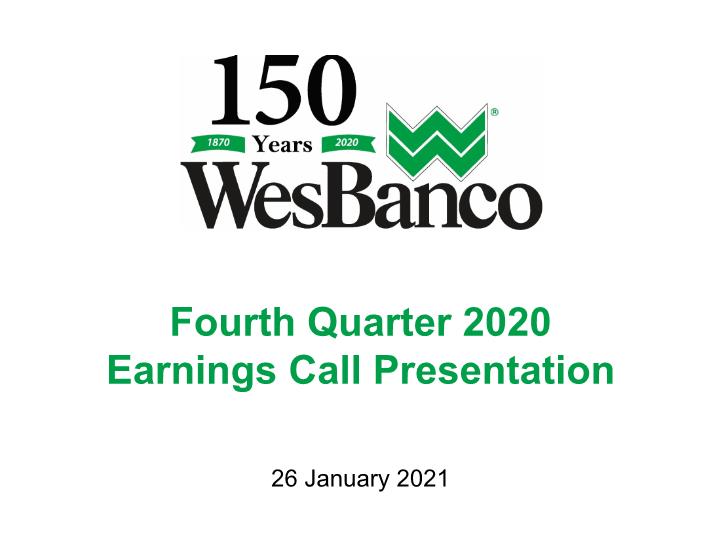
26 January 2021 Fourth Quarter 2020 Earnings Call Presentation
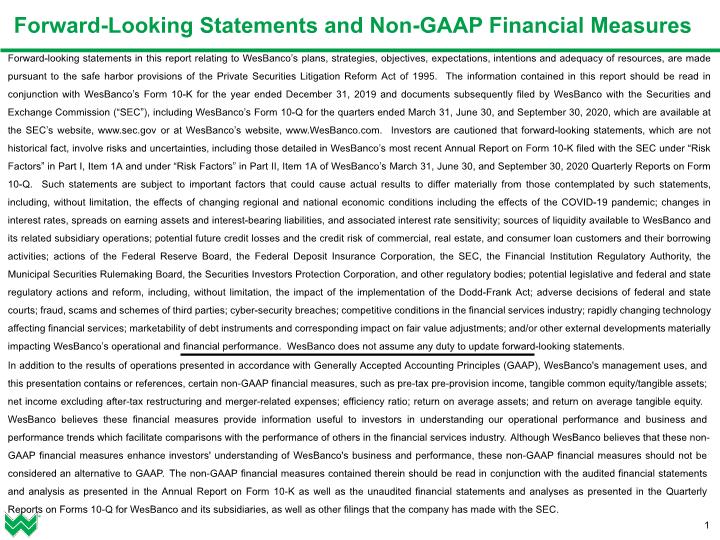
Forward-Looking Statements and Non-GAAP Financial Measures 1 Forward-looking statements in this report relating to WesBanco’s plans, strategies, objectives, expectations, intentions and adequacy of resources, are made pursuant to the safe harbor provisions of the Private Securities Litigation Reform Act of 1995. The information contained in this report should be read in conjunction with WesBanco’s Form 10-K for the year ended December 31, 2019 and documents subsequently filed by WesBanco with the Securities and Exchange Commission (“SEC”), including WesBanco’s Form 10-Q for the quarters ended March 31, June 30, and September 30, 2020, which are available at the SEC’s website, www.sec.gov or at WesBanco’s website, www.WesBanco.com. Investors are cautioned that forward-looking statements, which are not historical fact, involve risks and uncertainties, including those detailed in WesBanco’s most recent Annual Report on Form 10-K filed with the SEC under “Risk Factors” in Part I, Item 1A and under “Risk Factors” in Part II, Item 1A of WesBanco’s March 31, June 30, and September 30, 2020 Quarterly Reports on Form 10-Q. Such statements are subject to important factors that could cause actual results to differ materially from those contemplated by such statements, including, without limitation, the effects of changing regional and national economic conditions including the effects of the COVID-19 pandemic; changes in interest rates, spreads on earning assets and interest-bearing liabilities, and associated interest rate sensitivity; sources of liquidity available to WesBanco and its related subsidiary operations; potential future credit losses and the credit risk of commercial, real estate, and consumer loan customers and their borrowing activities; actions of the Federal Reserve Board, the Federal Deposit Insurance Corporation, the SEC, the Financial Institution Regulatory Authority, the Municipal Securities Rulemaking Board, the Securities Investors Protection Corporation, and other regulatory bodies; potential legislative and federal and state regulatory actions and reform, including, without limitation, the impact of the implementation of the Dodd-Frank Act; adverse decisions of federal and state courts; fraud, scams and schemes of third parties; cyber-security breaches; competitive conditions in the financial services industry; rapidly changing technology affecting financial services; marketability of debt instruments and corresponding impact on fair value adjustments; and/or other external developments materially impacting WesBanco’s operational and financial performance. WesBanco does not assume any duty to update forward-looking statements. In addition to the results of operations presented in accordance with Generally Accepted Accounting Principles (GAAP), WesBanco's management uses, and this presentation contains or references, certain non-GAAP financial measures, such as pre-tax pre-provision income, tangible common equity/tangible assets; net income excluding after-tax restructuring and merger-related expenses; efficiency ratio; return on average assets; and return on average tangible equity. WesBanco believes these financial measures provide information useful to investors in understanding our operational performance and business and performance trends which facilitate comparisons with the performance of others in the financial services industry. Although WesBanco believes that these non-GAAP financial measures enhance investors' understanding of WesBanco's business and performance, these non-GAAP financial measures should not be considered an alternative to GAAP. The non-GAAP financial measures contained therein should be read in conjunction with the audited financial statements and analysis as presented in the Annual Report on Form 10-K as well as the unaudited financial statements and analyses as presented in the Quarterly Reports on Forms 10-Q for WesBanco and its subsidiaries, as well as other filings that the company has made with the SEC.
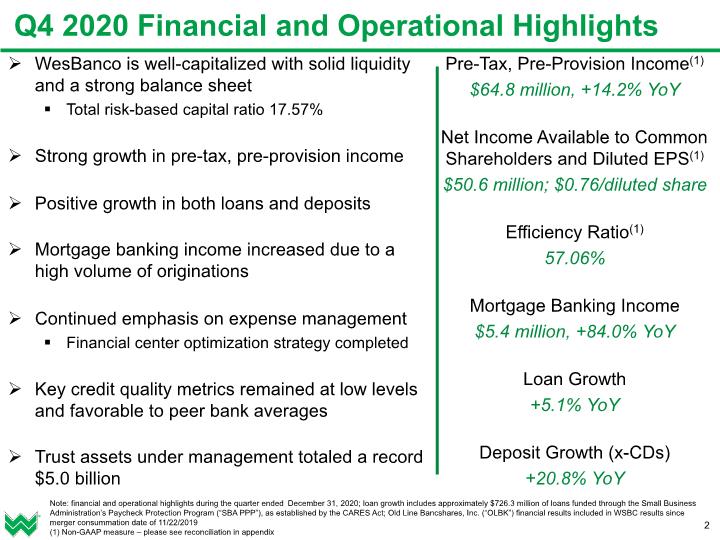
Q4 2020 Financial and Operational Highlights 2 Note: financial and operational highlights during the quarter ended December 31, 2020; loan growth includes approximately $726.3 million of loans funded through the Small Business Administration’s Paycheck Protection Program (“SBA PPP”), as established by the CARES Act; Old Line Bancshares, Inc. (“OLBK”) financial results included in WSBC results since merger consummation date of 11/22/2019 (1) Non-GAAP measure – please see reconciliation in appendix WesBanco is well-capitalized with solid liquidity and a strong balance sheet Total risk-based capital ratio 17.57% Strong growth in pre-tax, pre-provision income Positive growth in both loans and deposits Mortgage banking income increased due to a high volume of originations Continued emphasis on expense management Financial center optimization strategy completed Key credit quality metrics remained at low levels and favorable to peer bank averages Trust assets under management totaled a record $5.0 billion Pre-Tax, Pre-Provision Income(1) $64.8 million, +14.2% YoY Net Income Available to Common Shareholders and Diluted EPS(1) $50.6 million; $0.76/diluted share Efficiency Ratio(1) 57.06% Mortgage Banking Income $5.4 million, +84.0% YoY Loan Growth +5.1% YoY Deposit Growth (x-CDs) +20.8% YoY
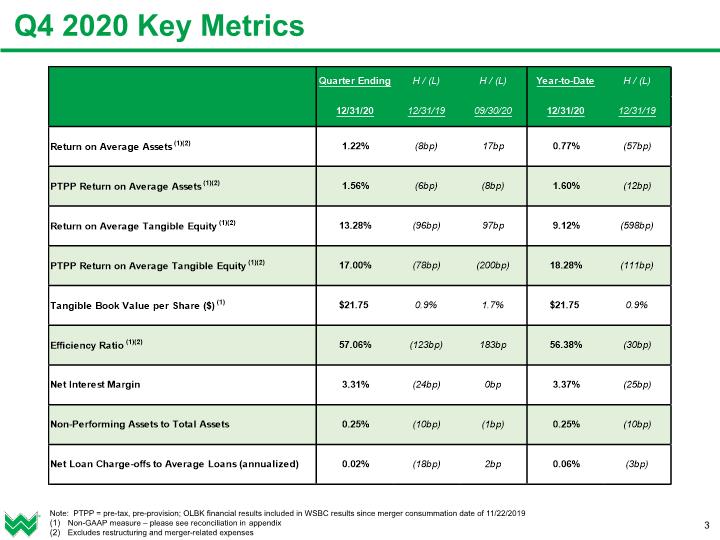
Q4 2020 Key Metrics 3 Note: PTPP = pre-tax, pre-provision; OLBK financial results included in WSBC results since merger consummation date of 11/22/2019 Non-GAAP measure – please see reconciliation in appendix Excludes restructuring and merger-related expenses
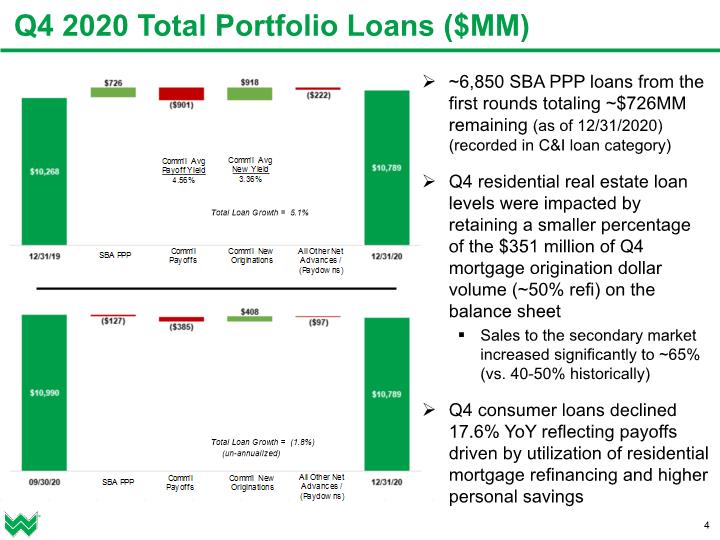
Q4 2020 Total Portfolio Loans ($MM) 4 ~6,850 SBA PPP loans from the first rounds totaling ~$726MM remaining (as of 12/31/2020) (recorded in C&I loan category) Q4 residential real estate loan levels were impacted by retaining a smaller percentage of the $351 million of Q4 mortgage origination dollar volume (~50% refi) on the balance sheet Sales to the secondary market increased significantly to ~65% (vs. 40-50% historically) Q4 consumer loans declined 17.6% YoY reflecting payoffs driven by utilization of residential mortgage refinancing and higher personal savings
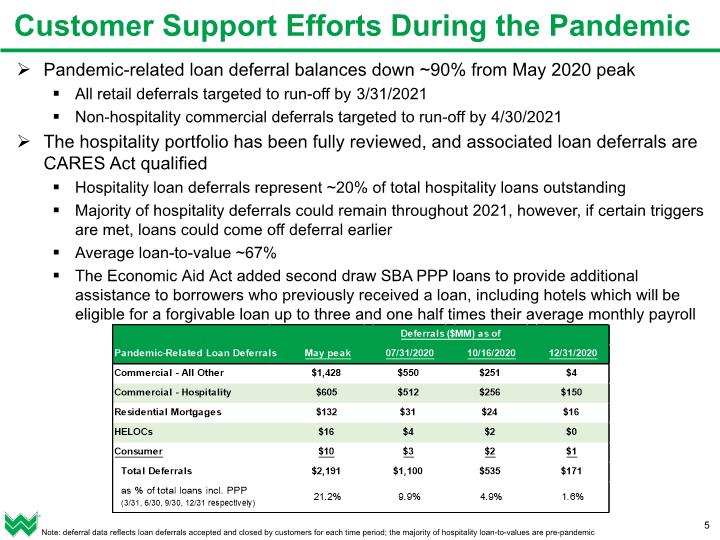
5 Customer Support Efforts During the Pandemic Note: deferral data reflects loan deferrals accepted and closed by customers for each time period; the majority of hospitality loan-to-values are pre-pandemic Pandemic-related loan deferral balances down ~90% from May 2020 peak All retail deferrals targeted to run-off by 3/31/2021 Non-hospitality commercial deferrals targeted to run-off by 4/30/2021 The hospitality portfolio has been fully reviewed, and associated loan deferrals are CARES Act qualified Hospitality loan deferrals represent ~20% of total hospitality loans outstanding Majority of hospitality deferrals could remain throughout 2021, however, if certain triggers are met, loans could come off deferral earlier Average loan-to-value ~67% The Economic Aid Act added second draw SBA PPP loans to provide additional assistance to borrowers who previously received a loan, including hotels which will be eligible for a forgivable loan up to three and one half times their average monthly payroll
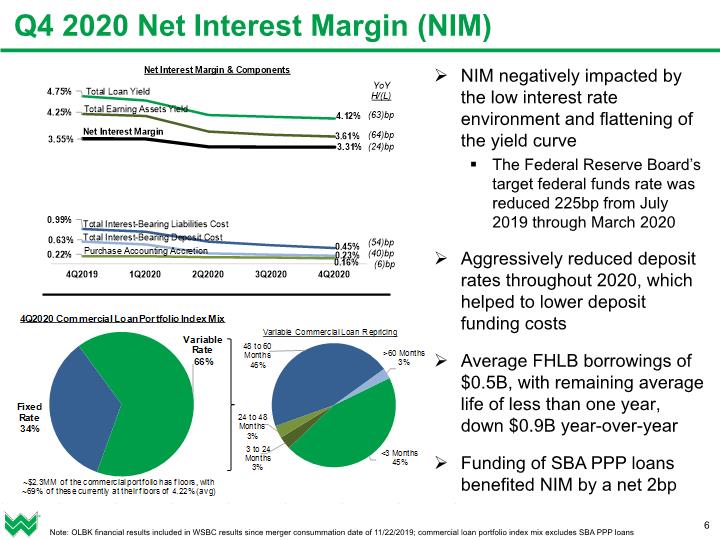
Q4 2020 Net Interest Margin (NIM) 6 NIM negatively impacted by the low interest rate environment and flattening of the yield curve The Federal Reserve Board’s target federal funds rate was reduced 225bp from July 2019 through March 2020 Aggressively reduced deposit rates throughout 2020, which helped to lower deposit funding costs Average FHLB borrowings of $0.5B, with remaining average life of less than one year, down $0.9B year-over-year Funding of SBA PPP loans benefited NIM by a net 2bp Note: OLBK financial results included in WSBC results since merger consummation date of 11/22/2019; commercial loan portfolio index mix excludes SBA PPP loans
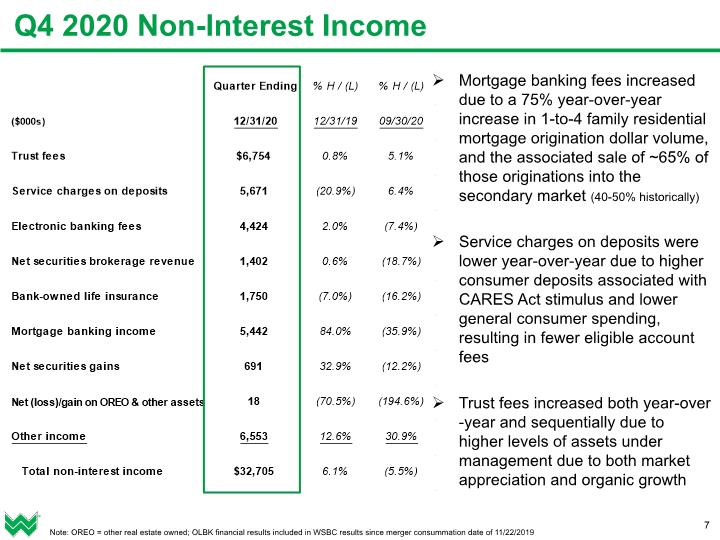
Q4 2020 Non-Interest Income 7 Mortgage banking fees increased due to a 75% year-over-year increase in 1-to-4 family residential mortgage origination dollar volume, and the associated sale of ~65% of those originations into the secondary market (40-50% historically) Service charges on deposits were lower year-over-year due to higher consumer deposits associated with CARES Act stimulus and lower general consumer spending, resulting in fewer eligible account fees Trust fees increased both year-over-year and sequentially due to higher levels of assets under management due to both market appreciation and organic growth Note: OREO = other real estate owned; OLBK financial results included in WSBC results since merger consummation date of 11/22/2019
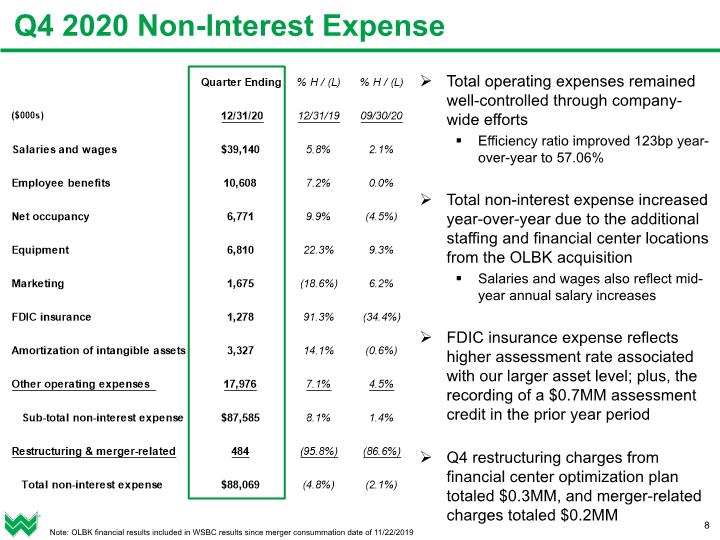
Q4 2020 Non-Interest Expense 8 Total operating expenses remained well-controlled through company-wide efforts Efficiency ratio improved 123bp year-over-year to 57.06% Total non-interest expense increased year-over-year due to the additional staffing and financial center locations from the OLBK acquisition Salaries and wages also reflect mid-year annual salary increases FDIC insurance expense reflects higher assessment rate associated with our larger asset level; plus, the recording of a $0.7MM assessment credit in the prior year period Q4 restructuring charges from financial center optimization plan totaled $0.3MM, and merger-related charges totaled $0.2MM Note: OLBK financial results included in WSBC results since merger consummation date of 11/22/2019
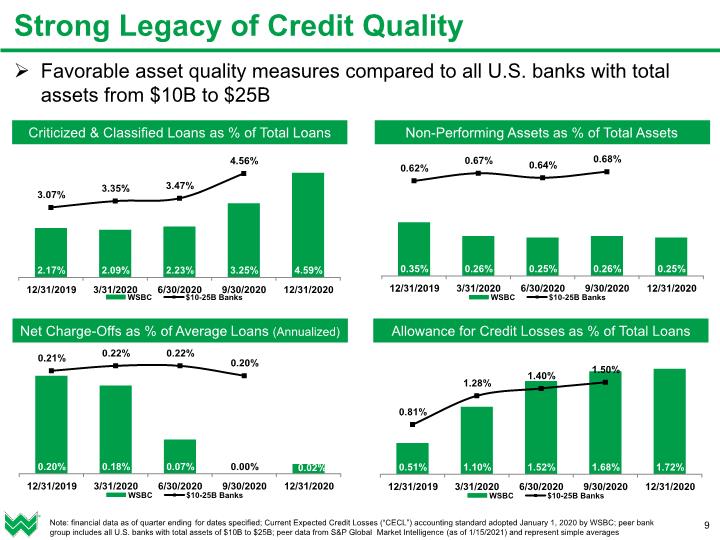
Non-Performing Assets as % of Total Assets Net Charge-Offs as % of Average Loans (Annualized) Allowance for Credit Losses as % of Total Loans Criticized & Classified Loans as % of Total Loans Favorable asset quality measures compared to all U.S. banks with total assets from $10B to $25B Strong Legacy of Credit Quality 9 Note: financial data as of quarter ending for dates specified; Current Expected Credit Losses (“CECL”) accounting standard adopted January 1, 2020 by WSBC; peer bank group includes all U.S. banks with total assets of $10B to $25B; peer data from S&P Global Market Intelligence (as of 1/15/2021) and represent simple averages
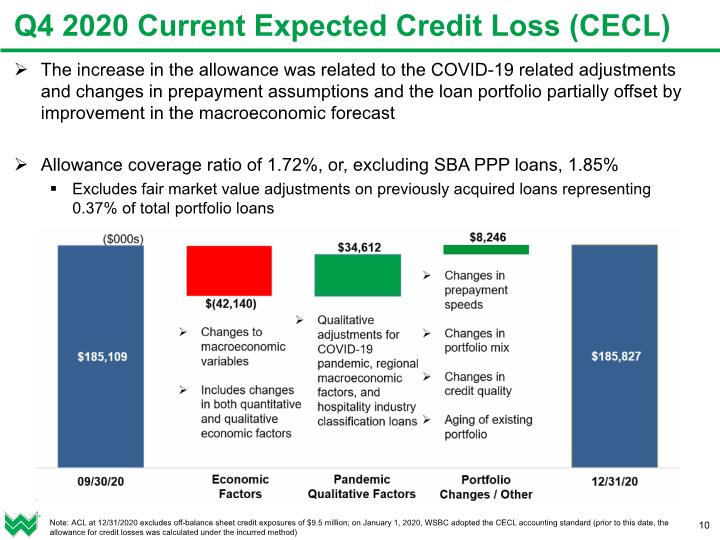
The increase in the allowance was related to the COVID-19 related adjustments and changes in prepayment assumptions and the loan portfolio partially offset by improvement in the macroeconomic forecast Allowance coverage ratio of 1.72%, or, excluding SBA PPP loans, 1.85% Excludes fair market value adjustments on previously acquired loans representing 0.37% of total portfolio loans Q4 2020 Current Expected Credit Loss (CECL) 10 Note: ACL at 12/31/2020 excludes off-balance sheet credit exposures of $9.5 million; on January 1, 2020, WSBC adopted the CECL accounting standard (prior to this date, the allowance for credit losses was calculated under the incurred method)
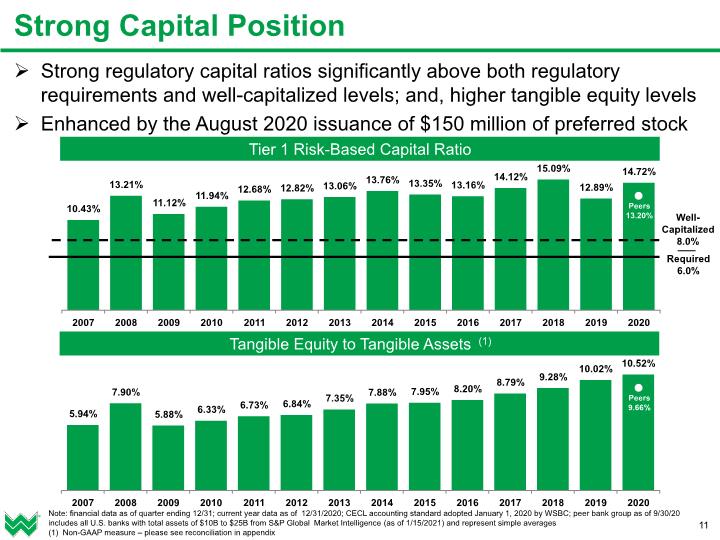
Tier 1 Risk-Based Capital Ratio 11 Strong Capital Position Strong regulatory capital ratios significantly above both regulatory requirements and well-capitalized levels; and, higher tangible equity levels Enhanced by the August 2020 issuance of $150 million of preferred stock Note: financial data as of quarter ending 12/31; current year data as of 12/31/2020; CECL accounting standard adopted January 1, 2020 by WSBC; peer bank group as of 9/30/20 includes all U.S. banks with total assets of $10B to $25B from S&P Global Market Intelligence (as of 1/15/2021) and represent simple averages (1) Non-GAAP measure – please see reconciliation in appendix Tangible Equity to Tangible Assets (1) Well-Capitalized 8.0% Required 6.0% Peers 13.20% Peers 9.66%
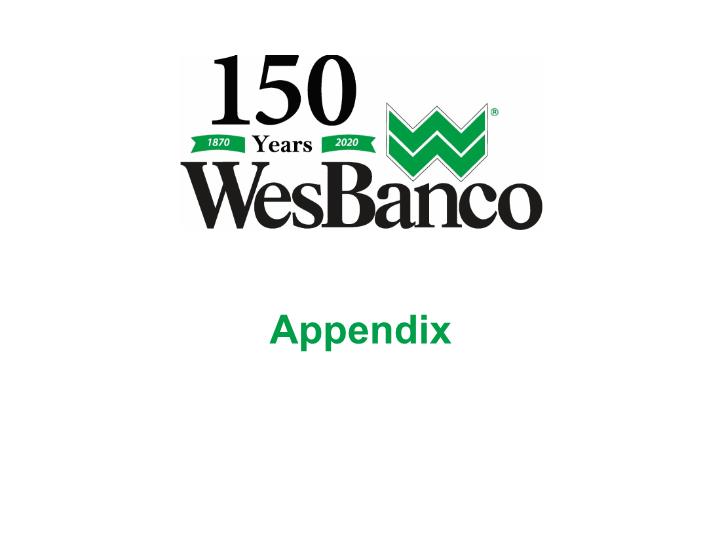
Appendix
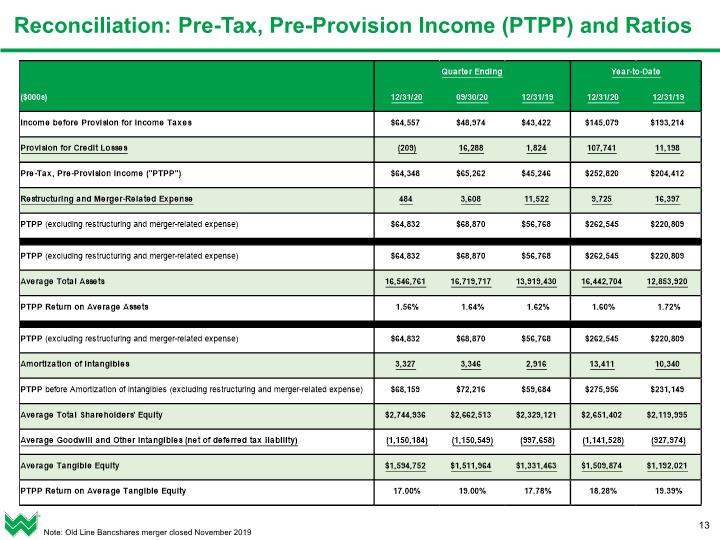
Reconciliation: Pre-Tax, Pre-Provision Income (PTPP) and Ratios 13 Note: Old Line Bancshares merger closed November 2019
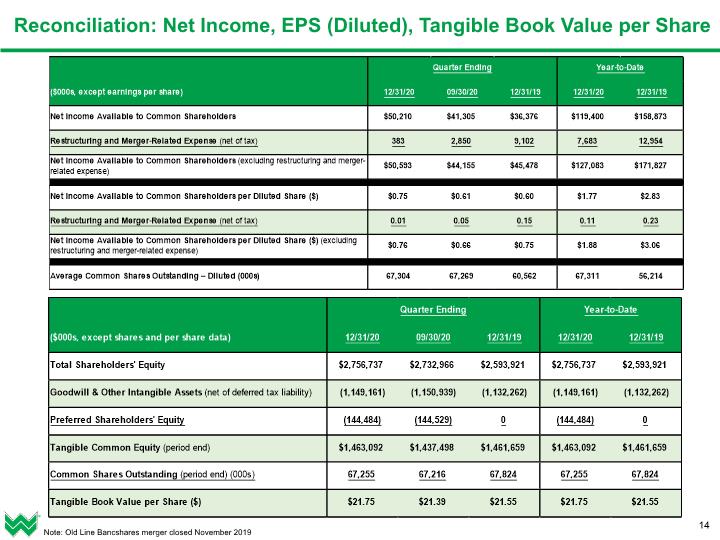
Reconciliation: Net Income, EPS (Diluted), Tangible Book Value per Share 14 Note: Old Line Bancshares merger closed November 2019
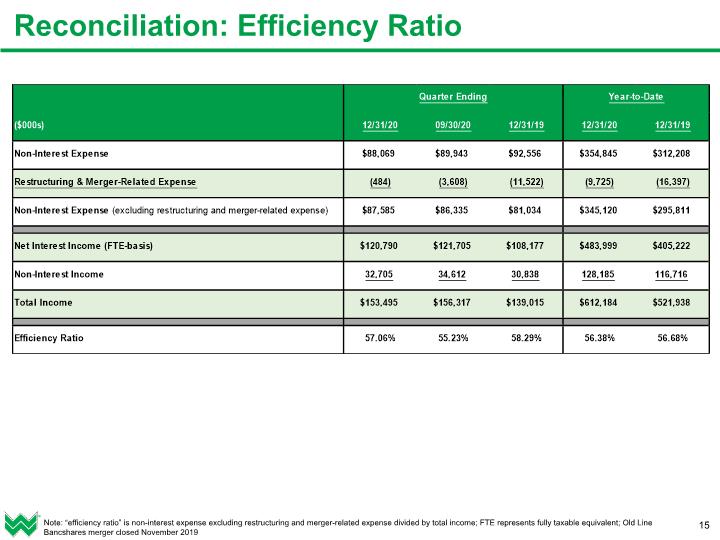
Reconciliation: Efficiency Ratio 15 Note: “efficiency ratio” is non-interest expense excluding restructuring and merger-related expense divided by total income; FTE represents fully taxable equivalent; Old Line Bancshares merger closed November 2019
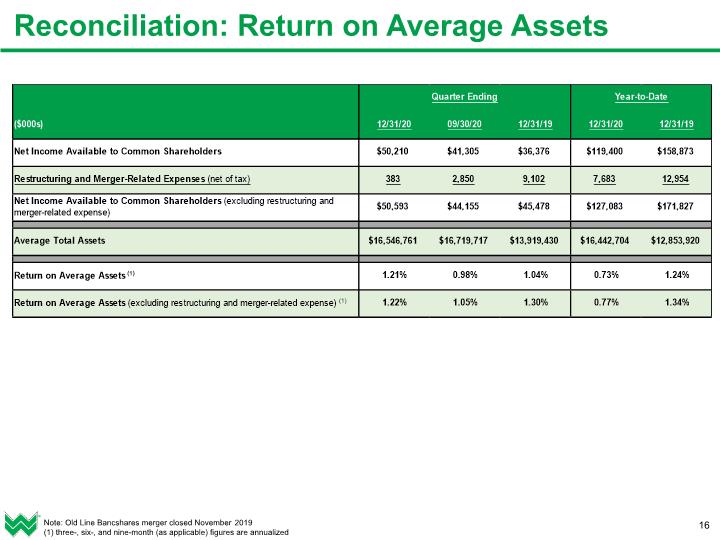
Reconciliation: Return on Average Assets 16 Note: Old Line Bancshares merger closed November 2019 (1) three-, six-, and nine-month (as applicable) figures are annualized
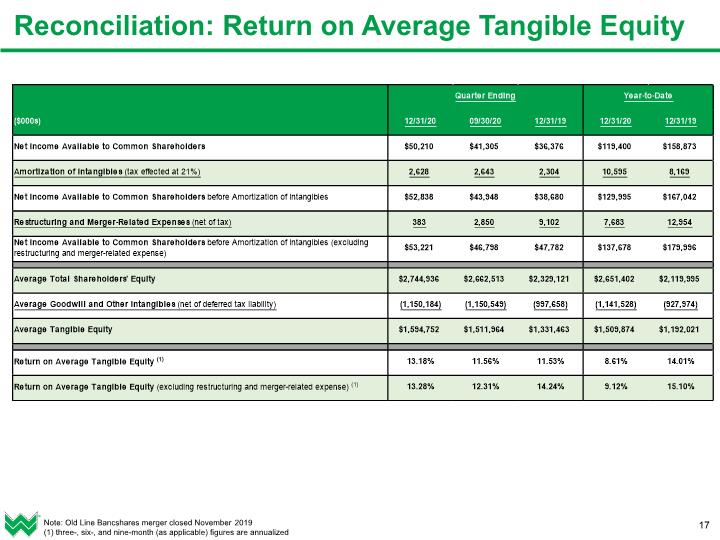
Reconciliation: Return on Average Tangible Equity 17 Note: Old Line Bancshares merger closed November 2019 (1) three-, six-, and nine-month (as applicable) figures are annualized
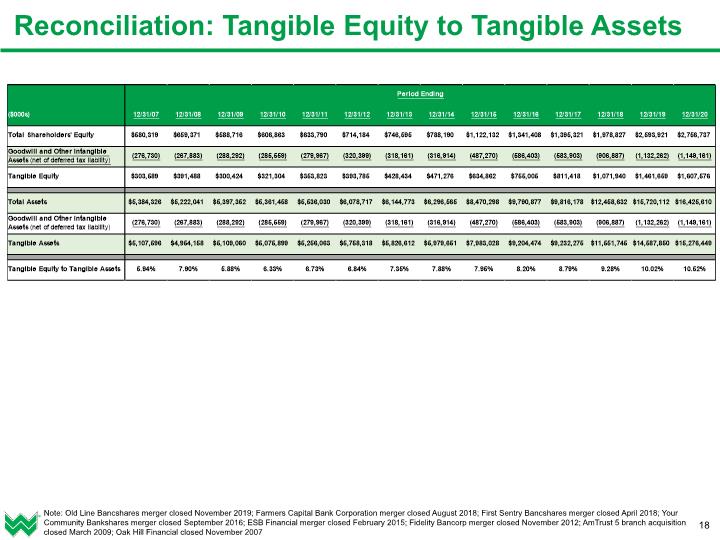
Reconciliation: Tangible Equity to Tangible Assets 18 Note: Old Line Bancshares merger closed November 2019; Farmers Capital Bank Corporation merger closed August 2018; First Sentry Bancshares merger closed April 2018; Your Community Bankshares merger closed September 2016; ESB Financial merger closed February 2015; Fidelity Bancorp merger closed November 2012; AmTrust 5 branch acquisition closed March 2009; Oak Hill Financial closed November 2007
